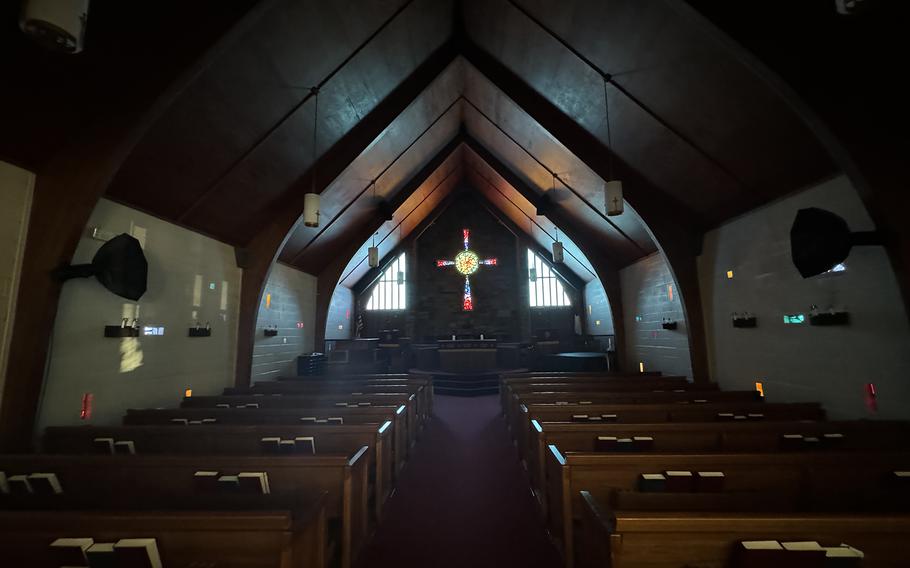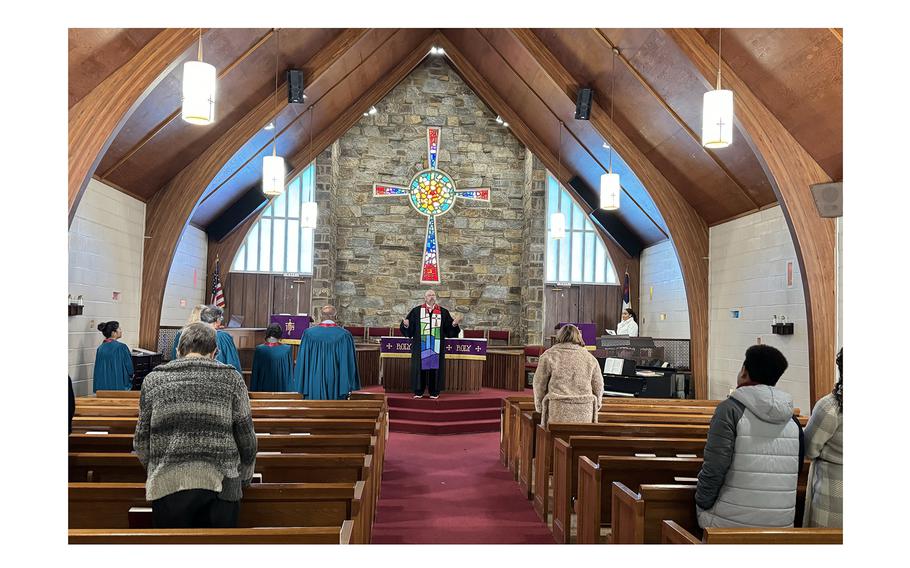
Northwood Presbyterian Church after the conclusion of a Sunday sermon. (Danny Nguyen/The Washington Post)
Northwood Presbyterian Church is, in a sense, a kind of home. People have gotten married in the cinder block building. They’ve sat with their kids in the pews and watched the Rev. Chris Deacon deliver sermons beneath the stained-glass cross for years.
But as the 15,000-square-foot church, which sits on seven acres on the edge of Silver Spring, Md., has seen its congregation shrink from 400 at its first service in 1958 to just above 100 in recent years, Deacon and his colleagues believe the church could be used to house people in a more literal way. Church officials have begun talking to developers about whether they can shrink the congregation’s physical space and convert parts of the property into affordable housing.
As churches across the region and the country have seen attendance decline - a decades-long trend hastened by the pandemic - some are examining creative ways to use their real estate to serve the public good. Chief among many churches’ concerns is the nationwide housing crisis, and some state and local governments are seeking to reduce the red tape that has hindered new housing development.
The country has 7.3 million fewer affordable rental housing units than are needed, according to researchers at the National Low Income Housing Coalition. A record 22.4 million households are spending more than 30 percent of their income on rent and utilities as evictions and homelessness surge, according to a recent report by the Joint Center for Housing Studies at Harvard University.
At Northwood, managing so much space isn’t worth the trouble anymore. “We’d much rather be putting that money into the mission,” said Alison Crichton, the clerk of session at Northwood. “I don’t want to be spending my life fixing bathrooms.”
Many states and cities have set goals of building tens or hundreds of thousands of affordable housing units within a decade. In the D.C. region, the Metropolitan Washington Council of Governments, a group of lawmakers and other leaders set a target of 320,000 new housing units between 2020 and 2030, at least three-quarters of which should be affordable to low- or middle-income households. To meet this goal, the region would have to build an average of more than 65 affordable units every day this decade.
Housing developed on church land could help significantly. In the D.C. region, faith-based institutions owned about 800 vacant parcels in 2019, wrote Peter A. Tatian, a senior fellow at the Urban Institute, and those parcels could hold up to 108,000 new homes.
But developers, which partner with churches for these projects, have long struggled to build enough affordable housing. Even with government incentives such as tax credits, they often don’t find these projects sufficiently profitable. It can take years to get zoning and design approvals, adding costs that can ultimately derail the project. The problem has become worse in a volatile post-pandemic economy that has brought surging construction costs and high interest rates, said Brett Theodos, a housing economist at the Urban Institute.
Local and state governments can help, but policymakers are often slow to act, said David Dworkin, president and CEO of the National Housing Conference, a consortium of affordable housing advocates. “Our policymakers are not aware that this time-intensive process can just kill an affordable housing project,” Dworkin said.

The Rev. Chris Deacon delivers a message during a Sunday service at Northwood Presbyterian Church in Silver Spring, Md., on Jan. 21, 2024, to a crowd that totaled 19 people. One attended online, he said. (Danny Nguyen/The Washington Post)
Northwood has already paid the price.
Last year, a developer approached Northwood with a proposal to redevelop much of the property into affordable housing, said Andrew Genova, managing director at Foundry Commercial, a real estate firm now handling the sale of the property. But the developer pulled out shortly afterward “due to the daunting process for going after affordable housing development,” Genova said. “Many prospective buyers get spooked.”
Such stories have become increasingly common, Theodos said. The root of the problem is usually the same. A developer can spend years securing local zoning and regulatory approvals to build large apartment buildings. All the while, the developer has to shell out property taxes and pay architects, designers and other workers as they negotiate the regulations. These delays typically account for 40 percent of a developer’s expenses, according to a joint study from the National Association of Home Builders and the National Multifamily Housing Council.
“I don’t think it’s fair to ask [developers] to operate at a loss or at a profit margin that’s significantly lower than market rate,” Dworkin said.
Low-income housing tax credits can help subsidize affordable housing, and Congress unveiled a $79 billion bipartisan tax package in January that would boost these credits, which lawmakers said could allow for more than 200,000 additional housing units across the country.
But construction costs aren’t the only thing that can upend a project. Housing developments can also draw opposition from neighbors concerned about noise, traffic and parking, known by their critics as “not-in-my-backyard” (NIMBY) groups. “Ambitious NIMBYs can delay a project almost indefinitely because eventually the developers are just not going to be able to afford to do it,” Dworkin said.
The leaders of Arlington Presbyterian Church, a small church on the first floor of an affordable housing complex just off Columbia Pike in Arlington, Va., wrestled with locals who tried to use historic-building protections to preserve the old church building, said the Rev. Ashley Goff, the church’s pastor. “They talk about the symbolism” of the old building, Goff said about the project’s opponents, some of whom were former church members. “But no, the church looked dead.” The church, chartered in 1908, says it had about 1,000 members in 1954 but just 40 by the end of 2022.
The old church was demolished in 2017; the building that replaced it has 173 affordable apartments.
Elsewhere in the country, policymakers have begun working to make it easier for church property to become housing with “yes in God’s backyard” (YIGBY) initiatives. A 2019 law in Washington state gave religious organizations density bonuses - the ability to build more units than zoning typically allowed - for building affordable housing on their land.

California Gov. Gavin Newsom (D) signed a law in 2023 that allows faith institutions and colleges to build affordable housing on their property even if local zoning prevents it. (Melina Mara/The Washington Post)
The biggest effort has come in California. In October, Gov. Gavin Newsom (D) signed a law allowing faith institutions and colleges to build affordable housing on their property even if local zoning prevents it. The law, which state officials say is the first of its kind, could slash the zoning process from years to months, said Philip Burns, principal of the Arroyo Group, an urban design and planning firm based in Pasadena, Calif.
“If you’re someone who does affordable housing, it’s a game changer,” said state Sen. Scott Wiener (D), who spearheaded the law. It could speed up housing construction on more than 171,000 acres of developable land owned by nonprofits and faith-based organizations across the state, he said.
D.C., Virginia and Maryland are looking to follow in California’s footsteps. The District, which has a shortage of more than 32,000 affordable rental homes, according to the National Low Income Housing Coalition, is funding initiatives to support affordable housing development on church land, including training and technical assistance for church leaders, that could yield thousands of homes. In Virginia, which needs more than 174,000 additional affordable rental homes, according to the coalition, lawmakers have introduced legislation that would streamline affordable housing development for faith-based institutions.
In Maryland, which has a deficit of 96,000 total housing units, according to the state legislature, Gov. Wes Moore (D) is pushing a bill that would streamline the zoning process and give affordable housing developers a density bonus. The bill, which would apply to nonprofits such as churches, would also limit the number of public hearings that local governments can require for eligible affordable housing projects, preventing groups from using these hearings to drag out project timelines. The state House and Senate are expected to complete their review of the bill next month.
This legislation, part of a package of housing initiatives proposed by Moore, is the “first step toward tackling the underlying causes that have increased our housing unit shortage, as well as pushed the cost of living higher for all Marylanders,” said Jake Day, Maryland’s secretary of housing and community development.
On a snowy Sunday morning in January, after Deacon delivered his sermon to 19 attendees scattered among empty pews and seats, he pondered the future of his church. He’s not sure whether it will become affordable housing. But one way or another, he hopes the reimagined church land will benefit the surrounding community.
“We might lose our beautiful sanctuary,” he said. “We might lose the building that you raised your kids in.” He hopes to preserve the stained glass he preached under. “But the church is not the building,” he said. “The church is the people, the congregation.”
He added, “The church goes on.”